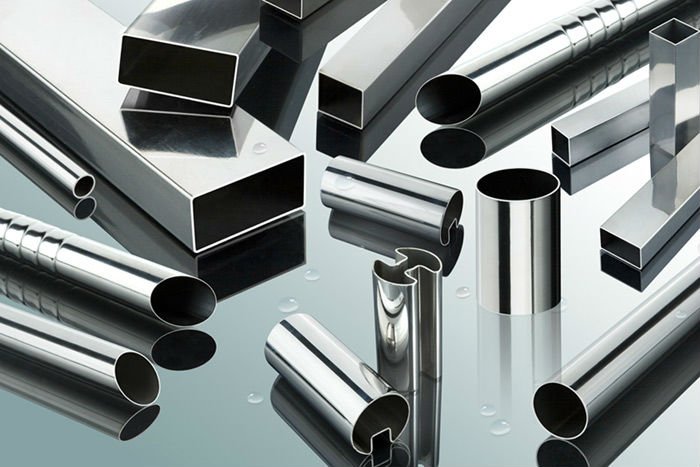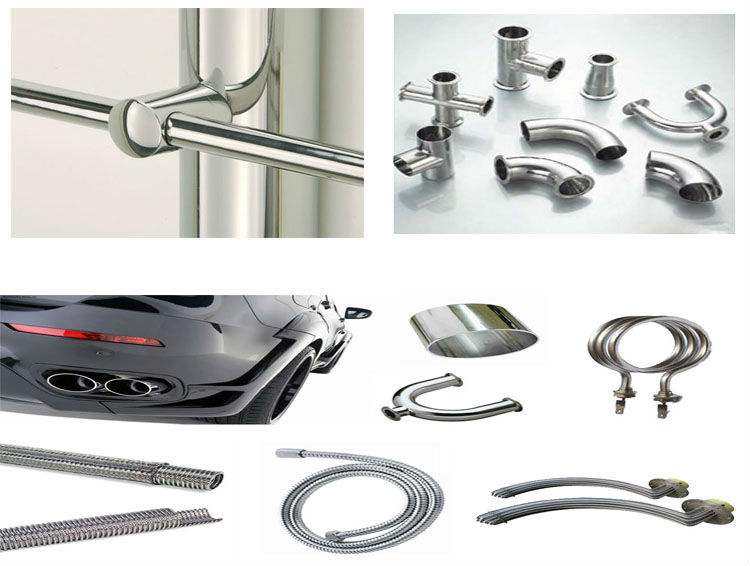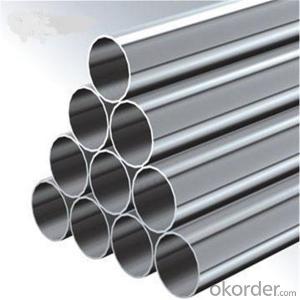TIG Welded 304 Stainless Steel Rectangular Tube/Pipe
- Loading Port:
- Shanghai
- Payment Terms:
- TT OR LC
- Min Order Qty:
- 5 m.t.
- Supply Capability:
- 25000 m.t./month
OKorder Service Pledge
OKorder Financial Service
You Might Also Like
Item specifice
eatures | 1.We are the coil agent in Foshan,offer coils to many other factories as the pipe material. |
2.We have more than 15 years experience in stainless steel market,a professional manufacturer. | |
3.We completely produce the pipes,from the material picking,rolling,striping,pipe making,polishing,and package all these procession. | |
Brand | ZaiHui |
Certification | ISO 9001:2008 |
ISO 14001:2004 | |
Standard | ASTM,AISI,JIS,DIN,EN,SUS,GB |
Type | Welded,TIG Welded |
Steel Grade | 201,202,301,304,316,430,304L,316L |
Surface Treatment | 180grit,240grit,320grit,400grit,500grit,600grit,HL,2B,Satin,Mirror.light,shiny,bright,brushed,mat |
Round pipe | |
Outer Diameter | 9.5,12.7,15.9,17,18,19.1,20,21,22,23,25.4,28,31.8,33,35,36,38.1,40,41.8,42,45,48,50,50.8,56,57,60,63.5,76.2,80,89,101.6,108,114,127, |
Thickness | 0.25mm to 3.0mm |
Length | 3000mm to 8000mm |
Square pipe | |
Side Length | 10*10,12*12,15*15,18*18,19*19,20*20,22*22,23*11,24*12,24*24,25*25,28*28,30*30,23*36,36*36,38*38,40*40,48*23,48*48,50*50, |
Thickness | 0.25mm to 3.0mm |
Length | 3000mm to 8000mm |
Tolerance | Thickness:+/-0.02mm; |
Length:+/-5mm | |
Quatity:+/-5% | |
Character | Rustproof, good corrosion resistance, anti-wearing, good-appearance, excellent mechanical properties. |
Application | Window,Door,Handrail,Curtain rail,Towel rail,Flagpole,Lamp pole,Sanitary Instrument,Billboard,Decoration,Upholstery, |
| Gade Chemical Composition | 201 | 202 | 301 | 304 | 316 | 430 | 304L | 316L |
| C | ≤0.08 | ≤0.06 | ≤0.06 | ≤0.06 | ≤0.08 | ≤0.12 | ≤0.03 | ≤0.03 |
| S | ≤0.02 | ≤0.02 | ≤0.03 | ≤0.03 | ≤0.03 | ≤0.03 | ≤0.03 | ≤0.03 |
| P | ≤0.075 | ≤0.06 | ≤0.045 | ≤0.035 | ≤0.045 | ≤0.04 | ≤0.045 | ≤0.045 |
| Mn | 8.5-10.5 | 7.5-10 | ≤2.0 | ≤2.0 | ≤2.0 | ≤1.0 | ≤2.0 | ≤2.0 |
| Si | ≤1.0 | ≤1.0 | ≤1.0 | ≤1.0 | ≤1.0 | ≤1.0 | ≤0.75 | ≤0.75 |
| Cr | 14-15 | 14-16 | 16-18 | 17-20 | 16-18 | 16-18 | 17-20 | 16-18 |
| Ni | 0.8-1.2 | 4-6 | 4-7 | 8-12 | 12-16 | ≤0.05 | 8-12 | 12-16 |
| Gade Physical Property | 201 | 202 | 301 | 304 | 316 | 430 | 304L | 316L |
| Density | 7.9 | 7.9 | 8 | 8 | 8 | 7.8 | 8 | 8 |
| The Conductivity | 16.3 | 16.3 | 16.3 | 16.3 | 14.2 | 26 | 16.3 | 16.3 |
| Specific Heat(0-100Cp) | 0.5 | 0.5 | 0.5 | 0.5 | 0.5 | 46 | 0.5 | 0.5 |
| Abrasion Resistance | Good | Good | Good | Good | Good | Good | Good | Good |
| Cold Forming | Fair | Good | Good | Good | Good | Good | Good | Good |
| Weldability | Good | Good | Excel | Excel | Excel | Fair | Excel | Excel |
| Melting Point | 1400-1420 | 1400-1420 | 1400-1420 | 1400-1450 | 1370-1400 | 1430-1510 | 1400-1450 | 1370-1400 |


3. Applications
Milk and food industry, pharmaceutical industry, industries with special internal surface requirements.

4. Stainless steel conservation
Stainless steel is a popular metal for appliances these days. Many kitchen appliances, both large and small, are made with stainless steel. Pots and pans and eating utensils are also made with stainless steel. One advantage of stainless steel is that is very resistant to rusting. But it can get rust stains from transference of rusty objects. You can keep stainless steel rust-free by following a few simple steps.
Clean frequently with a cleaner and water. Any cleaner that is safe for glass is usually safe for stainless steel.
Scrub off all rust from these objects with a scrubbing pad or steel wood pad. This means getting rid of rust from pots and pans before putting them into a stainless steel sink or on top of a stainless steel stove.
Put a rubber mat at the bottom of the stainless steel sink before placing rusted pots and pans (such as cast iron cookware) in the sink.
Apply a thin layer of lubricant (such as mineral oil) to the surface of the stainless steel. This prevents rust from forming.
Inspect equipment frequently, if you notice discoloration, tarnish or water stains, increase the frequency of your fresh water rinses to reduce accumulated chemicals
- Q:Are stainless steel pipes suitable for industrial applications?
- Yes, stainless steel pipes are highly suitable for industrial applications. Stainless steel is known for its excellent corrosion resistance, making it a preferred choice for various industries such as chemical, petrochemical, oil and gas, pharmaceutical, food and beverage, and many others. Stainless steel pipes can withstand high temperatures and pressures, making them ideal for transporting fluids and gases in industrial processes. They are also durable, strong, and have a long lifespan, which is crucial for heavy-duty industrial applications. Additionally, stainless steel pipes are easy to maintain and clean, reducing the risk of contamination in industries that require strict hygiene standards. Overall, stainless steel pipes offer numerous advantages that make them highly suitable and widely used in industrial applications.
- Q:Are stainless steel pipes suitable for hot water applications?
- Indeed, stainless steel pipes are well-suited for the purpose of hot water applications. Renowned for its remarkable resistance to corrosion, stainless steel proves to be the perfect candidate for incorporation in plumbing systems that involve the use of hot water. The ability of stainless steel to withstand high temperatures guarantees that it can endure the heat generated by hot water without suffering any deterioration or harm. Furthermore, the internal surface of stainless steel pipes possesses a sleek texture, thereby aiding in the preservation of the integrity and purity of the hot water during transportation. Ultimately, stainless steel pipes emerge as a dependable and long-lasting option for utilization in hot water applications.
- Q:Are stainless steel pipes fire-resistant?
- Yes, stainless steel pipes are fire-resistant. Due to their high melting point and excellent heat resistance, stainless steel pipes can withstand extreme temperatures and prevent the spread of fire, making them a reliable choice for fire protection systems.
- Q:What color is stainless steel? What color is stainless steel pipe culture?
- You want to draw the stainless steel, or to mirror the drawing, usually gray, mirror is generally bright silver, of course, the color is also there, ah, you need it
- Q:How do you calculate the maximum allowable deflection for stainless steel pipes?
- To determine the maximum allowable deflection for stainless steel pipes, various factors must be taken into consideration. Firstly, it is necessary to ascertain the material properties of the stainless steel being utilized, including its modulus of elasticity (E) and yield strength (σy). These properties can typically be obtained from material specifications or through testing. Following that, the allowable stress (σa) for the stainless steel pipe needs to be determined. Usually, this value is a fraction of the yield strength, typically around 0.4 or 0.5 times the yield strength, ensuring the pipe's safety and integrity. Once these values are known, the formula for deflection in a simply supported beam can be utilized to calculate the maximum allowable deflection: δ = (5 * w * L^4) / (384 * E * I) Here: δ represents the maximum deflection w denotes the load per unit length applied to the pipe L signifies the length of the pipe E represents the modulus of elasticity of the stainless steel I indicates the moment of inertia of the pipe's cross-section In this scenario, the load per unit length (w) can be calculated based on the weight of the material being transported or the external forces acting on the pipe. The moment of inertia (I) depends on the cross-sectional shape of the pipe. For instance, in the case of a circular pipe, the moment of inertia (I) equals (π * D^4) / 64, where D represents the diameter of the pipe. By plugging the known values into the formula, the maximum allowable deflection for the stainless steel pipe can be calculated. Ensuring that the calculated deflection remains within the maximum allowable limit is crucial for maintaining the structural integrity and functionality of the pipe.
- Q:What are the different finishes available for stainless steel pipes?
- There are several different finishes available for stainless steel pipes, including brushed, polished, satin, and mill finishes. These finishes can vary in appearance and texture, allowing individuals to choose the one that best suits their desired aesthetic and functional needs.
- Q:How do you prevent leakage in stainless steel pipes?
- To prevent leakage in stainless steel pipes, there are various steps that can be taken: 1. Installation should be done by trained professionals with expertise in working with stainless steel. This involves using suitable fittings, connectors, and seals to establish a tight and secure connection. 2. Regular inspections should be conducted to detect any signs of leakage, such as corrosion, cracks, or loose fittings. This allows for proactive maintenance and repairs before a significant leak occurs. 3. Opt for high-quality materials that meet industry standards when selecting stainless steel pipes. Inferior materials or substandard manufacturing can result in weak points and an increased risk of leakage. 4. Ensure proper sealing by using effective methods like gaskets, o-rings, or thread sealants to create a tight seal between pipe joints. This prevents any potential points of leakage. 5. Before putting the stainless steel pipes into operation, conduct pressure tests to ensure their integrity. This helps identify any weaknesses or leaks that may have occurred during installation. 6. Implement a regular maintenance schedule to inspect and maintain the stainless steel pipes. This includes checking for corrosion, replacing worn-out seals or gaskets, and tightening fittings as needed. 7. Avoid over-tightening fittings, as it can cause stress and damage to the pipe, leading to leaks. Follow the manufacturer's guidelines for proper tightening torque. 8. Properly support and secure stainless steel pipes to prevent stress or movement that can result in leaks. This involves using suitable hangers, clamps, or brackets designed for stainless steel pipes. By following these preventive measures, the likelihood of leakage in stainless steel pipes can be significantly reduced, ensuring the long-term integrity and reliability of the piping system.
- Q:Are stainless steel pipes suitable for food storage facilities?
- Stainless steel pipes are a perfect fit for food storage facilities. The food industry widely embraces stainless steel due to its many advantageous properties. Firstly, stainless steel's resistance to corrosion is crucial in food storage facilities where exposure to moisture and various food products is common. This resistance guarantees that the pipes will not rust or deteriorate over time, thus preventing any potential contamination of the stored food. Furthermore, stainless steel pipes are easy to clean and maintain, making them the ideal choice for food storage facilities that must comply with strict hygiene standards. The smooth and non-porous surface of these pipes prevents the buildup of bacteria, ensuring that the stored food remains safe and uncontaminated. Stainless steel is also a non-reactive material, meaning it does not release any harmful substances into the food. This is particularly important in food storage facilities, as it guarantees the preservation of the integrity and quality of the stored food products. Additionally, stainless steel pipes possess excellent strength and durability, enabling them to withstand the high pressures and temperature fluctuations commonly encountered in food storage facilities. This ensures that the pipes will not fail or break, providing a dependable and long-lasting solution. To conclude, stainless steel pipes are highly suitable for food storage facilities due to their resistance to corrosion, ease of cleaning, non-reactive nature, and strength. They create a safe and hygienic environment for storing food, thereby ensuring the preservation of the integrity and quality of the stored products.
- Q:Can stainless steel pipes handle high temperatures?
- Yes, stainless steel pipes are capable of handling high temperatures. Stainless steel is known for its excellent heat resistance, making it suitable for various applications that involve elevated temperatures. The specific grade of stainless steel used will determine the maximum temperature the pipes can withstand. For instance, austenitic stainless steel grades such as 304 and 316 can typically handle temperatures up to around 1600°F (870°C), while higher alloyed grades like 310 and 321 can withstand even higher temperatures. This heat resistance is due to the presence of chromium and other alloying elements in stainless steel, which form a protective oxide layer that prevents corrosion and oxidation at high temperatures. Therefore, stainless steel pipes are commonly used in industries such as petrochemical, power generation, and heat exchangers, where high temperatures are prevalent.
- Q:How do stainless steel pipes compare to brass pipes?
- Stainless steel pipes and brass pipes are both popular choices for various plumbing and industrial applications, but they have distinct differences that make them suitable for different circumstances. Firstly, stainless steel pipes are known for their exceptional durability and corrosion resistance. They can withstand high-pressure environments and are highly resistant to rust and corrosion, making them ideal for applications in harsh conditions or where water quality is a concern. Stainless steel pipes also have a higher melting point than brass pipes, which allows them to handle extreme temperatures without compromising their structural integrity. On the other hand, brass pipes are valued for their excellent thermal conductivity and malleability. They are often used in plumbing systems as they are easy to bend and shape, allowing for greater flexibility during installation. Brass pipes are also known for their aesthetic appeal, as they have a warm, golden color that can enhance the visual appeal of a space. In terms of cost, brass pipes tend to be more expensive than stainless steel pipes. However, brass pipes often have a longer lifespan and require less maintenance, which can offset the initial higher cost. Another factor to consider is the environmental impact. Stainless steel is a highly sustainable material as it is 100% recyclable, making it an eco-friendly choice. Brass, on the other hand, requires a significant amount of energy to produce and is less recyclable than stainless steel. Ultimately, the choice between stainless steel and brass pipes depends on the specific requirements of the project. If durability, corrosion resistance, and long-term reliability are the primary considerations, stainless steel pipes are the preferred option. However, if thermal conductivity, malleability, and aesthetic appeal are more important, brass pipes may be the better choice.
1. Manufacturer Overview |
|
|---|---|
| Location | |
| Year Established | |
| Annual Output Value | |
| Main Markets | |
| Company Certifications | |
2. Manufacturer Certificates |
|
|---|---|
| a) Certification Name | |
| Range | |
| Reference | |
| Validity Period | |
3. Manufacturer Capability |
|
|---|---|
| a)Trade Capacity | |
| Nearest Port | |
| Export Percentage | |
| No.of Employees in Trade Department | |
| Language Spoken: | |
| b)Factory Information | |
| Factory Size: | |
| No. of Production Lines | |
| Contract Manufacturing | |
| Product Price Range | |
Send your message to us
TIG Welded 304 Stainless Steel Rectangular Tube/Pipe
- Loading Port:
- Shanghai
- Payment Terms:
- TT OR LC
- Min Order Qty:
- 5 m.t.
- Supply Capability:
- 25000 m.t./month
OKorder Service Pledge
OKorder Financial Service
Similar products
New products
Hot products
Hot Searches
Related keywords





























